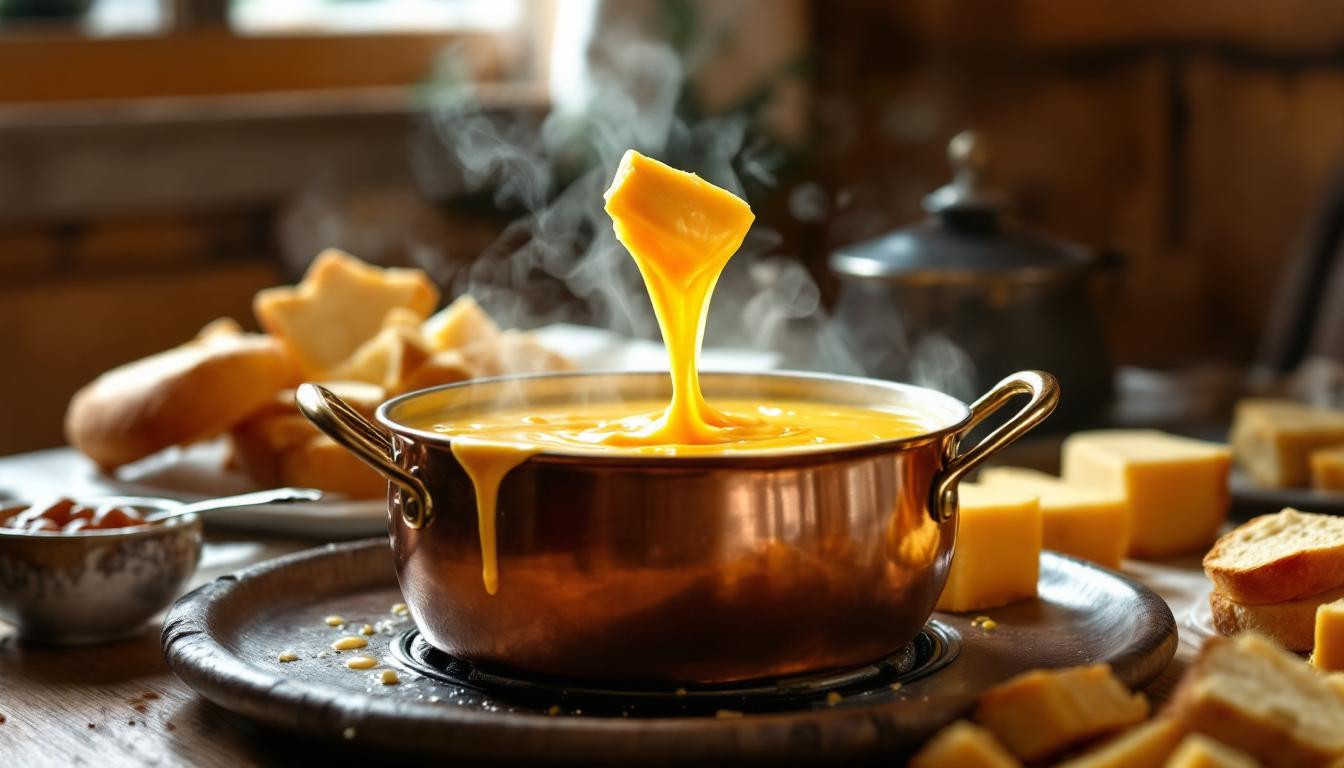There’s something almost magical about gathering around a bubbling pot of cheese fondue. Growing up in my grandmother’s Alpine chalet, fondue night was sacred – a ritual that transformed ordinary evenings into celebrations. I can still hear the gentle bubble of the wine-infused cheese and see the golden threads stretching from pot to bread. This isn’t just dinner; it’s an experience deeply rooted in Swiss tradition, where leftover cheese and stale bread became a communal feast that has endured for centuries. 🧀
The Soul-Warming History of Swiss Fondue
Fondue began as humble peasant fare in the isolated Swiss mountains, where villagers needed to make hardened cheese and stale bread palatable during harsh winters. The genius combination of wine and cheese created not just a meal but a tradition of togetherness. What fascinates me is how this necessity-born dish became Switzerland’s national treasure – a testament to culinary ingenuity born from scarcity rather than abundance. 🏔️
As a young chef training in Geneva, I learned that a proper traditional Alpine cheese fondue follows strict protocols. My mentor would say, “Alex, respect the cheese and it will respect your palate.” That wisdom has stayed with me for decades.
The Perfect Cheese Blend
The soul of fondue lies in its cheese. While variations exist across Alpine regions, the classic mixture combines:
- 8 oz (225g) Gruyère cheese, grated – aged at least 6 months for depth
- 8 oz (225g) Emmental cheese, grated – for elasticity and mild sweetness
- 2 tablespoons (20g) cornstarch – the traditional binding agent
- 1 cup (240ml) dry white wine – preferably Swiss Fendant or Sauvignon Blanc
- 1 tablespoon fresh lemon juice – balances the richness
- 1 garlic clove, peeled
- ¼ teaspoon freshly grated nutmeg
- 1 tablespoon kirsch (cherry brandy) – optional but authentic
The Fondue Ritual
The preparation of fondue is as important as its ingredients. Follow these steps for cheese perfection:
- Cut the garlic clove in half and thoroughly rub the inside of your fondue pot (caquelon). Leave the garlic in the pot.
- Toss the grated cheeses with cornstarch in a bowl until evenly coated. This prevents clumping and creates silky texture.
- Pour wine into the pot and heat over medium-low until small bubbles form (do not boil).
- Add lemon juice and stir.
- Reduce heat to low and add the cheese mixture one handful at a time, stirring in a figure-eight motion until completely melted before adding more.
- Once all cheese is incorporated and mixture is smooth, stir in nutmeg and kirsch (if using).
- Transfer to a fondue stand with a heat source beneath to maintain the perfect consistency.
Chef’s Note: The most common fondue mistake is rushing. Add cheese gradually and stir constantly. If your fondue begins to separate, whisk in 1 teaspoon of cornstarch dissolved in a splash of cold wine. Trust your wrist – the resistance against your spoon should feel like stirring heavy cream, not pudding.
Beyond the Bread Cube
While crusty bread cubes are traditional, explore these dipping options:
- Blanched vegetables like broccoli, cauliflower and crispy roasted potatoes
- Tart apple slices that cut through the richness
- Cured meats like speck or prosciutto
- Crispy Turkish flatbreads torn into pieces
No proper fondue is complete without understanding the traditions. In Switzerland, if a man loses his bread in the pot, he buys drinks; if a woman does, she kisses her neighbors. The crispy cheese layer (la religieuse) that forms at the bottom is the cherished reward for the patient. 🍷
When serving fondue, I like to pair it with a crisp white wine identical to what’s in the pot – creating a harmony of flavors. The acidity in wine cuts through the richness, much like how a bright tomato sauce balances fatty pasta.
I often finish my fondue gatherings with light cloud-like scones and fresh berries. The tradition says to drink only white wine or hot tea with fondue – never cold water or other beverages, which Swiss grandmothers swear cause the cheese to form an indigestible ball in your stomach. Who am I to argue with generations of Alpine wisdom? Gather your loved ones, prepare your caquelon, and create memories around the bubbling pot of golden treasure. In these moments of shared indulgence, we connect with centuries of tradition and with each other. 🫕
